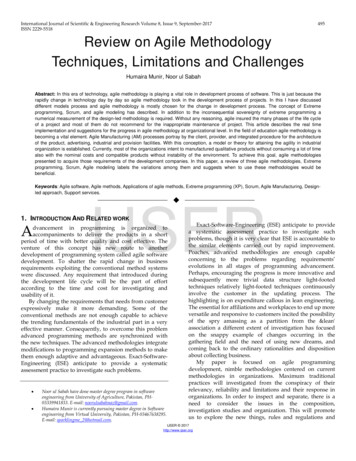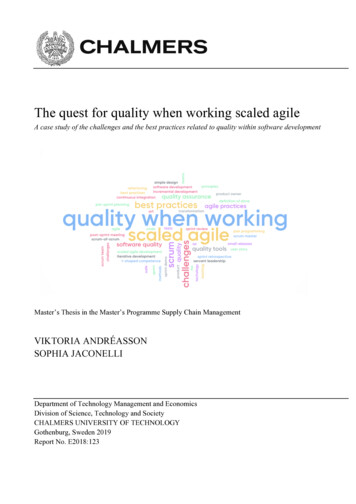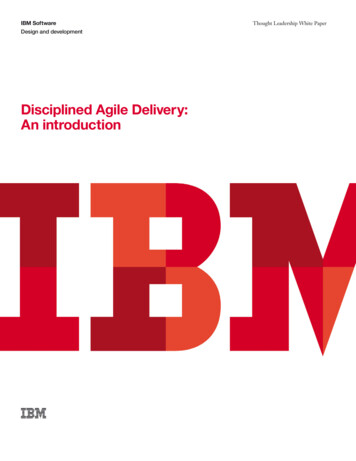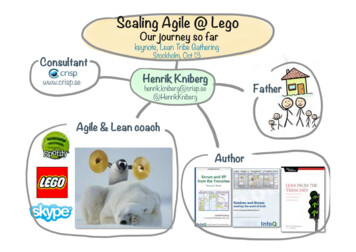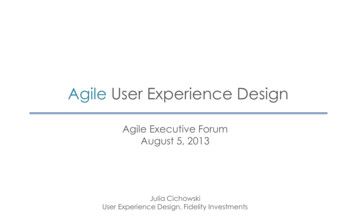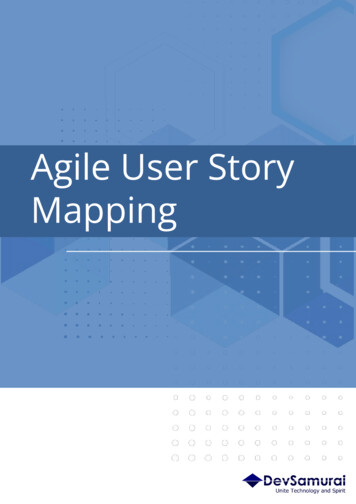
Transcription
Agile User StoryMapping
Contents2Agile User Story Map & Product Roadmapfor Jira & Confluence3An Introduction to Agile Product Management5What is Product Management?5Example of user stories7Workflow tools and Agile8Agile Product Backlog9What is User Story Mapping?10Why use User Story Mapping?10How to do User Story Mapping?11Example of User Story Mapping12When is User Story Mapping Not Suitable?12User story mapping steps13About DevSamurai17User Story Maphttps://www.userstorymap.io/
User Story Maphttps://www.userstorymap.io/3
An Introduction to AgileProduct ManagementAgilesoftwaredevelopmentWhat is Product Management?approaches recommend thatrather than building the fullstated requirement, that justenough is built to allow thecustomer or stakeholder tointeract with the system so thattheycanreviewtheworkcompleted and reconsider thenext steps.This is callediteration.Originally coined in 1995 by Agile Manifesto founder KenSchwaber, product management is a concept which formallyacknowledges that key software systems should be treated asongoing and evolving endeavours with a focus on value(products) rather than one-off deliveries with a focus ondelivering against an unchanging plan (projects).Product managers facilitate this process by maximising thevalue delivered by their product and they do this by prioritisingand pursuing the items that are likely to yield the most valuewhen balanced against the effort to implement.Product managers and product owners work closely with avariety of stakeholders, both internally (employees) andexternally (end-users and third parties) in order to understandnot only what they say they want (requirements), but to formtheories and hypotheses about what they might need and not yetknow (experimental test and learn).User Story Maphttps://www.userstorymap.io/4
An Introduction to AgileProduct ManagementCapturing RequirementsPart of being a product manager is speaking to stakeholders to understand what behavioursthey want the system to exhibit and how they want it to function. This is where we get the term“functional requirements”.Functional RequirementsFunctional requirements are so-called because they are functions required by someone,usually stakeholders, and the requirement is related to the system being built. An example would be“I want to be able to log in to the system”.Product managers are often subject matter experts regarding the product they are managing,so they may often write their own requirements. In such circumstances, they need to be careful thattheir requirements are validated with research otherwise there is the danger that the productbecomes built to their own subjective requirements rather than externally validated ones.Agile software development approaches recommend that rather than building the full statedrequirement, that just enough is built to allow the customer or stakeholder to interact with thesystem so that they can review the work completed and reconsider the next steps. This is callediteration.Non-Functional Requirements (NFRs)When requirements relate to technical requests, these are called “non-functionalrequirements”, which are specifications for the system that do not directly affect the user-facingbehaviour. An example of this would be “User passwords should be encrypted to the AES 256standard”.Non-functional requirements are very important as they relate to the security, performance,scalability and integration of the system being built, but it is easy to forget non-functionalrequirements until it is too late and that’s why it’s common to see large I.T. projects fail; it’s not thatthe user-facing design was wrong, it’s that insufficient rigour was invested into specifying the bits thatyou don’t see.It is also common to see the reverse of the above issue where systems are over-engineered inregard to the NFRs. This usually happens because either people have taken an overly risk averseapproach to the NFRs (e.g. stating that a system must be available 99.999% of the time when it’s onlyrequired during working hours) or they’ve used an example set of NFRs from a different project.With the above points in mind it’s important to ensure that NFRs are “right-sized” andappropriate for the product being built to prevent failures which might impact business continuity,but also prevent overspend and overengineering, which can carry a burdensome resource load.Product Requirements DocumentWhen requirements are being gathered they are often captured in a product requirementsdocument (PRD), which is a list of the stated requirements along with explanations of what they areand why they are required.This list of requirements can then be used to write a series of actionable backlog items for thedevelopment team to start implementing. Such backlog items are often written as “user stories”.5User Story Maphttps://www.userstorymap.io/5
An Introduction to AgileProduct ManagementUser Story MappingFrom the PRD we can then begin to start writing our list of user stories, and a useful approachto take is a user story mapping approach as follows:Vision Goals Activities Tasks User StoriesIt often helps to use the separate steps of the customerjourney as an aide memoire to writing the user story map as itensures no element is left out.User StoriesUser stories, introduced by the eXtreme Programming (XP)movement, are a way of representing requirements in a series ofsimple statements. The structure is as per their name in that firstly,the requirement must be linked to an end-user and secondly, theymust be written as a story, rather than a solution.An example of a good user storyAn example of a bad user storyAs a shopperAs a Product OwnerI want to search for cheap itemsI want to optimise the DB by changing selectqueries to limit queriesSo that I can save money on my shoppingSo that it performs fasterThis is a good example because it lets a personreading the story understand who the user is,what they want to achieve and why they want toachieve it. Further discussions can now occuras to how this story could be delivered. Forinstance, you could allow sorting of searchresults from lowest to highest, or you couldhave a quick link which displays a pagecontaining items priced under 5.The point of this is, there are multiple solutionsto a problem and if you jump to a solution tooearly then there is the risk that you choose thewrong solution.This is a bad example because firstly, a productowner is not a user, so we don’t understandwhich user persona we are directly benefitingby completing this task (unless you happen tobe building a system for Product Owners!).Secondly, the approach to resolution has beenpre-solutionedwithoutanyroomfornegotiation and thirdly, the outcome doesn’treally state how the task adds any businessvalue, as a faster database in itself does notcreate value.User stories: A reminder to have a conversationA good user story is a reminder to have a conversation with your users, stakeholders anddevelopment team about how to solve the stated problem (not a reminder that a conversationhas already occurred!). In fact, the process of implementing user stories is stated to be “The threeCs” as follows:① Card – The writing of the user story② Conversation – The discussion about how to achieve the desired outcome③ Confirmation – The process of confirming that the outcome has been achievedUser Story Maphttps://www.userstorymap.io/6
An Introduction to AgileProduct ManagementIt is common, however, to see user stories written with full solutions attached before thedevelopment team has seen the item and this tends to be reflective of organisations who have movedtowards agile from a more top-down waterfall approach.This isn’t necessarily a catastrophicproblem, but certainly better resolutions are achieved when the people implementing them arecorrectly engaged.Workflow tools and AgileOriginally, agile software development teams managed their workload using whiteboards knownas “information radiators” which were separated into columns with sticky post - it notes to representuser stories and indeed some teams still operate like this today.The purpose of the information radiator is to provide transparency, both within the team andoutside the team so that the status of progress on an item can easily be known. Whether it is inprogress, done or not yet started; it is important that people with a vested interest can makethemselves aware of this progress and preferably without having to disturb the developer by asking “isthis done yet?”.With the advent of distributed teams and remote working, there was a move towards virtualteam boards, stored inside computer-based workflow tools. Some popular workflow tools include“Jira” and “Trello” both owned by Atlassian and also “Azure Devops” by Microsoft.Such workflow tools allow you to create detailed backlog items, containing not only the originalproblem statement or user story, but all of the associated conversations, images, process flows, linksto relevant code snippets and much more. These items then move across a virtual whiteboard from“To Do” all the way to “Done”.A happy side effect ofusing virtual workflow tools isthat you have a detailed auditrecordalreadycompletedshowing how long an item took,who requested it, who worked onit, what the solution was andeven a link to the specific codethat the developer committed totheir repository. There have beensomecriticismsofworkflowtools, namely that they changethe focus of the team to spendtoo much time on administeringthe tool itself and that the way inWith that in mind, it’s important to ensure that the team iswhich some teams work thenworking in the best way for itself and the organisation, bybegins to change to reflect theensuring that the scrum master or agile coach working with thelanguage and default workflow ofteam, guides them to make appropriate choices about ways ofthe tool itself.working.User Story Maphttps://www.userstorymap.io/7
An Introduction to AgileProduct ManagementAgile Product BacklogOnce the PRD has been distilled into a set of user stories, these stories need to be storedsomewhere in priority order. The name for the place that this to-do list is stored is the “ProductBacklog”. It’s the product manager or product owner’s responsibility to ensure that the productbacklog is in priority order so that the team knows which items will create the most value.Once the backlog has been created, further discussions can begin with the team in a processknown as “refinement”. This allows the necessary detail to be added to user stories to allow thedevelopment work on them to proceed.Although the product manager specifies the priority order of the backlog, the team is free tochoose items from it in the way that best makes sense, as they are better informed with regards to thedependencies involved in the development process.Product management is a complex area, ensuring that the views of all relevant stakeholders areconsidered, prioritised, assessed for value and then translated into actionable development items.Product managers need to be able to speak to people from a diverse range of backgrounds such asboard level directors, users and developers.As with everything in agile, this is an iterative process where improvements are made along theway, both to the engagement process with stakeholders as well as the development of the productitself.By using our Jira plug in you can help smooth the product management process by providing aneasy to read view of your user stories and user story map, including the progress and priority of eachone.User Story Maphttps://www.userstorymap.io/8
What is User Story Mapping?A common challenge for manyWhy use User Story Mapping?organizations is how to takethehighlevelstatedrequirements from senior staff,stakeholders and users andtranslate them into actionableand logically ordered items.Even if you write a long anddetailed list it can be verydifficult to read, consume andcheck for omissions.ManyIn traditional waterfall projects, lengthy requirementsdocuments would be prepared, which development teams wouldwork against until all stated sections were deemed to be met. Atthis point the project would move into a testing phase and then auser acceptance testing phase. Although these documents can beuseful in terms of providing a large amount of information, thereare some drawbacks to their inflexible and unwieldy nature.User stories have been widely accepted as the de-factostandard for conveying requirements to development teams, butjust a long list of user stories can be a bit confusing to thosepeople are visual learners andconsuming it, both from a stakeholder perspective and from aso respond well to a visualdeveloper perspective.picture.User story maps provide an easy to view, structured,transparent and contextual view of user stories ensuring that anyof the required steps for the journey have not been missed.User Story Maphttps://www.userstorymap.io/9
What is User Story Mapping?How to do User Story Mapping?The user story mapping process consists of the following steps01. Identify your high level activitiesThis can be done by reviewing the user journey for the relevant part of the system that youwant to create the map for. Activities are also known as “Goals” or “Themes”. How?: Such journeysshould be relatively clear and apparent from the high level requirements, but should be reconfirmedwith the relevant stakeholders.Once you have this list of activities you arrange them inchronological order from left to right as if you were telling the story of your user’s journey02. Document the stepsDocument the steps required to complete all the necessary functionality in order to achievethe activities. These steps are often individually labelled as epics as they tend to encompass closelylinked groups of user stories and tasks and are often referred to as the “backbone” of the story map,as they provide much of the structure.03. Identify the detailsThese will be the actual user stories and tasks required at a fine granular level. These are bestfleshed out in conjunction with not only the stakeholders who are asking for the functionality, butalso with the team who will be building it to ensure the best solutions are designed.Once you have the map laid out you can start identifying natural slices of the product thatwould be suitable as user releases. The best way of developing software involves continuousintegration so that software is integrated and released in a little and often fashion, but just becausethe code has been merged to the code base it doesn’t mean you have to make every small changeavailable to the user immediately.User Story Maphttps://www.userstorymap.io/10
What is User Story Mapping?Example of User Story MappingScreenshot from DevSamurai Agile User Story Map for JiraThe below image shows an example user story map covering elements of a user log in pageand changing of account details for an e-commerce site. Note that the blue boxes map to activities,the orange boxes to steps and the grey boxes more to the details of how the specific items will beachieved.When is User Story Mapping Not Suitable?User story mapping won’t work in every situation. If there is no clear user journey, such aswith API building work then it would be quite difficult to use. If your team was doing moreoperational response, such as fixing bugs or responding to user issues, then it would not be possibleto create a user story map for such work.In a highly experimental agile environment where the next iteration’s work was highlydependent on the outcome of the experiments from the last release, such as a startup in thediscovery phase, extensive user story mapping would also not be possible, although you could atleast use it to plan the next increment of delivery.User story mapping is a highly interactive and visual method of representing a list of statedrequirements from stakeholders, senior employees and users of the system in a chronological andstructured way.It provides a highly transparent way of examining the functionality which has been identified tothe build, the order in which to build it and the desired release slices that will be made available tothe users.User Story Maphttps://www.userstorymap.io/11
User story mapping stepsDiscoverPersonas andGoalsMap the lsNeedsPainPoints/Frustrations- PersonalityTypes- Actor- Scenario andexpectedresults- Phases of thejourney- Actions,Mindset&Emotions- OpportunitiesDesignthinkingadvisesFocus onthemostimportantthings first-Slice outrelease/sprintIdentifylogicalpackages offunctionalityto release tothe usersStep 1: Discover Personas and GoalsA persona is a profile of an individual who may interact with the system in a unique orindividual way. To ensure that all the relevant requirements have been considered and understood,an early activity will need to be conducted to identify and discover user personas. A user personatends to be presented as a one-page card with information such as: Name (An example name to reflect thatparticular persona) Age (An indicative age reflective of peoplewho exemplify that persona) Bio (A short description about thispersona) Goals (The things that they mainly want toachieve in life) Needs (The things they need to achievefrom the system being built)User persona creation form – Agile User Story Map for Jira Pain Points / Frustrations (A list of thingsthat annoy or slow this user down) Personality Types (Are they outgoing, shy,User Story Maphttps://www.userstorymap.io/reserved, detail-oriented?)12
User story mapping stepsA persona is a profile of an individual who may interact with the system in a unique orindividual way. To ensure that all the relevant requirements have been considered and understood,an early activity will need to be conducted to identify and discover user personas. A user personatends to be presented as a one-page card with information such as:Step 2: Discover Personas and GoalsOnce personas have been identified, they can each be reviewed in turn based on all of thethings each person might want to achieve from the system. Once this full list of interactions with theproduct has been listed, they can be written down in a visual timeline known as a user journey map.The user journey map is a visual representation of a customer’s interaction with your productfrom start to finish, showing how they achieve the things that they need to and what steps they needto go through in order to reach this destination.The best products optimise their user journeys to ensure that objectives can be achieved bytheir customers in as few steps as possible. The reason for optimising the journey is that there aremany competing products on the market and customers will naturally gravitate towards those thatmake their lives as easy as 1.Actor: To which persona does this part ofthe journey map refer2.Scenario and expected results: Whatobjective is the actor trying to achieveand what outcome do we expect3.Phases of the journey: which may includephases that are completed outside of thesystem. As an example – a user buying awireless speaker from an ecommerce shopwould first see the speaker advertised,Map persona with the user journey – Agile User Story Map forJirathen buy it, then take delivery, then try itand finally may even return it.4. Actions, Mindset & Emotions Actions: The specific behaviours and steps taken by users Mindset: users’ thoughts, questions, motivations at various stages throughout the journey Emotions – a line showing highs and lows of the journey, so that these can be leveraged orimproved as appropriate5.OpportunitiesArmed with the above information, what do we need to do/change/improve and who owns whichaction? How will we measure whether a change has been made, what metrics will we use?Once we have our identified journeys mapped out, built on our user personas, we can then start toidentify the solutions we are going to put in place in order to satisfy these requirements.User Story Maphttps://www.userstorymap.io/13
User story mapping stepsStep 3: Explore solutionsWhen exploring solutions a good approach to use is “Design Thinking”. Design thinking advisesthat the best designs come from casting the net wide initially, then focusing in on defined solutions,before developing and testing a wide range of solutions and finally, narrowing down to the winningexperiments.The above model was built on further byPlattner et al, and as can be seen below it isnotalinearprocesswithadefinedbeginning and end, but rather an If we were starting with abrand new product, we may start at the‘empathise’ phase, however, for pre-existingproducts we could start elsewhere such as‘test’, ‘define’ or ideate.So called “winning experiments” then becomethe chosen and preferred solutions to thechallenges and opportunities posed by theresearch in the user persona phase (also part ofthe “empathise” phase of the above diagram).In this way, we can ensure that we havewell-researched and tested solutions, ratherthan just solutions that people from the projectteam have proposed.These can then betranslated into user stories or product backlogitems for the team to turn into workingsoftware.Step 4: PrioritiseTo prioritise is to focus on the most important thingsfirst. In software development, there are a number ofdifferent ways of prioritising the work to becompleted. Product owners or those focused moreon the functional side of the project are likely toconsider the things which generate value to be of thehighest priority. However, developers and technicalmembers of staff are likely to have a different view ofpriority, as they will focus more on the things that arelikely to make the system robust, performant andeasy to develop on.User Story Maphttps://www.userstorymap.io/14
User story mapping stepsOne of the more popular development frameworks, “Scrum” advises that the product ownershould order (prioritise) the backlog of work in a way that they find the most appropriate (in practicethis tends to be by value), but that the development team may implement the work in the way thatthey choose. The development team is guided by the order of work, but not bound by it.It is important that the development team is able to choose the order in which they implementthe work because non-technical staff may not understand the things that need to be completedbehind the scenes in order to make a fully functional product. Additionally, there may be a significantreduction in effort by delivering a high priority item with a low priority item, the so-called “whilstyou’re under the hood” factor.In true agile development, the most value is said to come from the work that is going to yieldfeedback the earliest. This means that there is value in even delivering a non-functioning button on apage if it allows for feedback to be received.In practice, it depends heavily on what is being built, the culture of the organisation and usergroup and the appetite for experimentation as to the correct metric to use for prioritisation.Step 5: Slice out development release/sprintOnce the personas have been identified, the journey has been mapped and the componentdeliverables have been ordered and prioritised in a suitable way with feedback from across the team,it is then possible to begin identifying logical packages of functionality to release to the users,otherwise known as “release slices”.Thepersonas,journeymapandsolutions can be translated into a set ofdeliverable items using user storymapping to create the lower-level tasksthat the development team will turninto working software in order to buildthe product.Slide the release in Agile User Story Map for JiraRelease slices can also be utilised as the product goal in Scrum teams, with the individual sprintgoals all working towards that release. This allows teams to begin to forecast forthcoming sprints,using a high-level sprint goal per sprint, until everything is completed to allow the release slice to bemade available to end-users. It should of course be noted that such forecasts are not a binding plan,and should not be represented to stakeholders as such.Whilst development teams working to best practice aim for continuous integration, delivery anddeployment to production as a way of ensuring good code quality, it may not always be suitable tomake the latest functionality available to users immediately. This is because when building a newphase of a user journey it often does not make sense to release the functionality until the full phaseof the journey has been completed.Development teams can balance the need for continuous deployment as a good coding practice, withthe requirement to only release chunks of functionality, by using feature flags. Feature flags allowcode to be released to the production environment and tested but not actually visible to end usersuntil the feature flag is enabled. When the flag is enabled this requires no release or coding, merely aflag to be toggled and then the functionality becomes available, which is how many “releases” arecompleted.User Story Maphttps://www.userstorymap.io/15
About DevSamurai“DevSamurai, Inc is an IT services firm based in Japan and APAC. We provide DevOps, systemdevelopment services and solutions such as Robotic Process Automation (RPA), AI Chatbots toautomate business and IT processesWe help customers to transform IT to next level with latest cloud computing platform, devopstools and best practices. Our team provide industry leading consulting expertise, service delivery,cutting edge products and solutions to all steps of Software Development Life Cycle (SDLC). OurRobotic Process Automation (RPA) and Chatbots solutions also empower organizations to automatebusiness processes. We free customers from repetitive tasks to only focus on producing valuableoutcomes.Member ofFind us on Atlassian MarketplaceContact Us58-6 Oyaguchikitacho, Itabashi-ku,Tokyo 173-0031 Japan4F Shiroyama Trust Tower,Toranomon 4-3-1, Minato City, Tokyo,105-6004 Japaninfo@devsamurai.com050 362 78910https://www.devsamurai.com/
It often helps to use the separate steps of the customer journey as an aide memoire to writing the user story map as it ensures no element is left out. An example of a good user story An example of a bad user story As a shopper I want to search for cheap items So that I can save money on my shopping This is a good example because it lets a person


